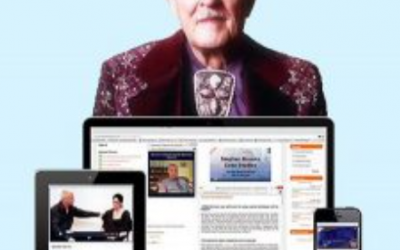🎁 Exclusive Discount Just for You!
Today only: Get 30% OFF this course. Use code MYDEAL30 at checkout. Don’t miss out!
High Quality Information Gathering and Application of Therapeutic Nominalisations Recognising Minimal Cues Of Trance Creating Dependent Tips
Stephen Brooks – Hypnotherapy Lectures – Part 1
(*1*)
This course is based upon 120 skills and techniques that are essential These areas are covered:
Principles of indirect Hypnosis
– The Interactional Approach
– The Intrapersonal Approach
– Economic language: Implication, compression, and implication
– Substitution of Symptoms and Resolution
– The Relationship Between Cause And Symptom
– Response Attentiveness
– Achieving positive outcomes
Communication with the Unconscious
– Identifying Verifiable Objectives
– Values, Criteria, and Beliefs
– Trauma, Abreaction
– Identifying and Defeating Sabotage Strategies
– Therapeutic Orientation: Change or Improvement?
Motivation of the patient to stay in therapy
Future Pacing
– Indirect and Secondary Benefits
– Weaning Patients off Therapy
– Understanding the Patient’s metaphors
– Contextualising Change
– Organic metaphors, and Symptom Based metaphors
– Advanced Strategies for Dealing with Failure
– Pursuing Relevance
The Structure of Learned Experience
– The Framing Model and Irrationality
– Time and context frames
Benefits and Costs
– The Laws of Attachment, and Nonattachment-Attachment
– Types of Decision Making Personality
– Anchoring & Conditioning
Feedback Loops
– The Laws of Concentrated Effort, Reversed, and Concentrated Effort
– The Laws of Positive Emotion and Reinforcement
– The Laws of Utilization, Observation, and Reframing
Indirect Hypnosis Techniques
Hypnotic Time Deformation
– Leisure Trance Inductions and Favorite Activity
– Pseudo-Hypnosis Orientation in the Time
– Hypnosis – Positive Negative Incorporation
– The Third Person Separation
– Hypnotic Catalepsy
– Arm Levitation inductions
– Automatic Writing in Hypnosis
– Unconscious Negotiation in Hypnosis
– Induction: Recalling Past Trance
– Surprise Technique Inductions
– The Therapeutic metaphor
– Multiple Mirror Therapeutic Induction
– Age Regression Techniques
– Paradoxical Intervention
– The Old Master Induction
– Subdirect Use-Modalities
– Uptime downtime induction
– Utilising The Patient’s Needs As A Motivational Strategy
Stop Smoking Strategy
– Inducing Amnesia
– The Self-Suggestion Induction
– Teach Your Patient Self-Hypnosis
– Induction of the Four Seasons
Crystal Gazing and Multiple Screens
– Non Verbal inductions
Ideo-Motor Signaling
– The My Friend John Induction
– Cellular healing therapy
– Induction of the Early Learning Set
Scrambling Symptoms
Ambiguous Task Assignments
Eye Fixation and Distraction inductions
– The Confusion induction
Deep Trance Identification
– Hypnosis to Pain Control and Anaesthesia
Skills in Indirect Hypnosis
– Taking the Patient’s History
High Quality Information Gathering
– How to Create and Apply Therapeutic Nominalizations
Recognizing the Minimal Cues in Trance
– Making Dependent Suggestions
– Open Questioning
– Negative and Reverse frames
– Sorting patterns of association
Get your instant download Stephen Brooks – Hypnotherapy Lectures – Part 1
– Adjunctive Suggestions
– Calibrating to Positive & Negative Response Cues
– Polarity Responses:
– Double Binding Classes
Suggestions for Passive Response
– Using Therapeutic & Hypnotic Double Entendre
– Post Hypnotic Suggestions
– Serial Suggestions
– Challenges Negative Nominalizations
– Sensory Based Predicates
– Open-Ended Suggestions
Resource Accessing
– Calibration of Facial Symmetry
– Injective Eye Contact
– Recognising Patients’ Subjective Interpretations
– Casting Doubt and Challenging a Patient’s Interpretations
– Getting Sequence Responses & Video Descriptions
– Designing Therapeutic Tasks
– Delivering and prescribing tasks
– How to develop a compassionate and empowered person
Integrity & Ethics
– Patient confidentiality is vital
Integrity and ethics in hypnotherapy practice
– It might be better to work with a partner-The therapist
– How to keep patient records safe
– When should you stop receiving treatment?
– Legal and ethical business management and practice
– Current status and codes of practice for hypnosis
Hypnosis: Medical and psychological contraindications
– It is important to ask for feedback and follow up-Up
– Recognizing psychiatric illness and when to refer
– Establishing clear guidelines about cost and duration
Practitioner Development
– CBT, psychodynamic and humanistic psychology
– Hypnosis research methodology
– Hypnosis’ history as a therapeutic approach
– Objective assessment of professional skill development
– The value and necessity of supervision and continuing training
Basic anatomy and physiology
Recent advances in brain science and mind research
Recognize the effects of previous treatments on therapy
The Hypnotic Relationship
– Showing compassion and concern to those in crisis
– Patient lifestyle and health management.
– Patient relationships and social skills.
– Support groups and resources available in the local area for patients.
– Identifying the patient’s expectations regarding outcomes
– Counter transference and transference
– Involving patients in treatment.
– Secondary or External Influences that Affect Therapy
– Contextualizing treatment to the patient’s environment
How to communicate clearly therapeutic options
– Emotions and patients’ perceptions.
– How can you negotiate mutually agreeable therapeutic outcomes
– Assessing the effectiveness of treatment
These are the 10 Lectures This section contains:
31. Positive Results
32. Polarity Responses:
33. Paradoxical Intervention
34. Communicating with the Unconscious
35. Induction to the Old Master
36. Sub-Modalities
37. Eye Accessing and Rep Systems
38. Identifying verifiable goals
39. Past Life Therapy
40. Beliefs, criteria and values
Course Features
- Lectures 0
- Quizzes 0
- Duration Lifetime access
- Skill level All levels
- Students 117
- Assessments Yes


